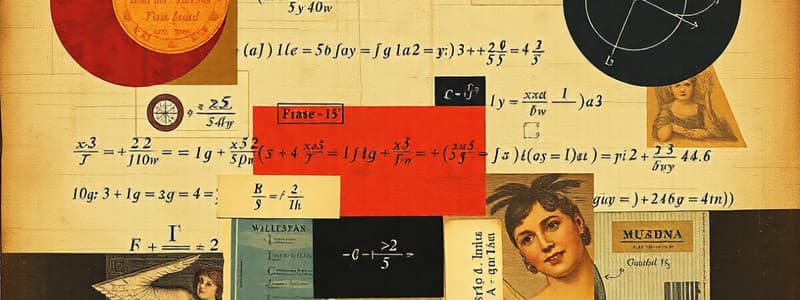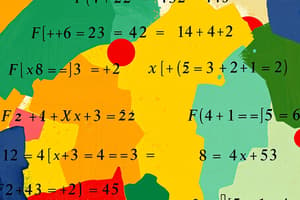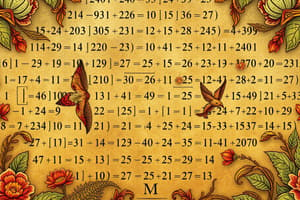Podcast
Questions and Answers
What is the first step to solve the equation $2x + 4 = 10$?
What is the first step to solve the equation $2x + 4 = 10$?
- Subtract 4 from both sides. (correct)
- Add 4 to both sides.
- Multiply both sides by 2.
- Divide both sides by 2.
Which of the following describes a quadratic function?
Which of the following describes a quadratic function?
- Has no intercepts.
- Involves only first-degree terms.
- Graph forms a straight line.
- Graph forms a parabola. (correct)
In the expression $5x^3 - 2x + 7$, what is the coefficient of the term with $x$?
In the expression $5x^3 - 2x + 7$, what is the coefficient of the term with $x$?
- 7
- -2 (correct)
- 5
- 3
When rearranging the inequality $3x - 5 < 7$, what is the next step after adding 5 to both sides?
When rearranging the inequality $3x - 5 < 7$, what is the next step after adding 5 to both sides?
What is the purpose of factoring an algebraic expression?
What is the purpose of factoring an algebraic expression?
What does the slope of a line indicate about its graph?
What does the slope of a line indicate about its graph?
Which operation must you reverse when solving inequalities?
Which operation must you reverse when solving inequalities?
In the equation $y = mx + b$, what does 'b' represent?
In the equation $y = mx + b$, what does 'b' represent?
Flashcards are hidden until you start studying
Study Notes
Algebra
Basic Concepts
- Variables: Symbols (usually letters) that represent unknown values.
- Constants: Fixed values that do not change.
- Expressions: Combination of variables, constants, and operations (e.g., (3x + 5)).
- Equations: A statement that two expressions are equal (e.g., (2x + 3 = 7)).
Operations
- Addition and Subtraction: Combining or removing values.
- Multiplication and Division: Repeated addition or partitioning values.
- Order of Operations: Follow PEMDAS/BODMAS:
- Parentheses/Brackets
- Exponents/Orders
- Multiplication and Division (left to right)
- Addition and Subtraction (left to right)
Solving Equations
- One-variable equations: Isolate the variable (e.g., (2x + 4 = 10) becomes (x = 3)).
- Multi-variable equations: Requires additional equations to solve (systems of equations).
Types of Equations
- Linear Equations: Equations of the first degree (e.g., (y = mx + b)).
- Quadratic Equations: Equations of the second degree (e.g., (ax^2 + bx + c = 0)).
- Polynomial Equations: Involves terms with variables raised to whole number powers (e.g., (x^3 - 4x^2 + x - 6 = 0)).
Functions
- Definition: A relation that assigns exactly one output for each input.
- Types:
- Linear Functions: Graph forms a straight line.
- Quadratic Functions: Graph forms a parabola.
- Polynomial Functions: Composed of multiple terms with varying degrees.
Graphing
- Coordinate System: Uses the Cartesian plane; x-axis (horizontal), y-axis (vertical).
- Slope: Measure of steepness of a line; calculated as (m = \frac{y_2 - y_1}{x_2 - x_1}).
- Intercepts: Points where a line crosses axes (x-intercept, y-intercept).
Inequalities
- Definition: Statements showing the relationship of one expression relative to another (e.g., (x > 3)).
- Solving: Similar to equations but reverse the inequality sign when multiplying or dividing by a negative number.
Common Algebra Techniques
- Factoring: Breaking down expressions into products of simpler expressions.
- Distributive Property: (a(b + c) = ab + ac).
- Completing the Square: Method to solve quadratic equations or convert standard into vertex form.
Key Terms
- Coefficient: Numerical factor in a term (e.g., in (4x), 4 is the coefficient).
- Like Terms: Terms that have the same variable raised to the same power.
- Polynomial Degree: Highest power of the variable in the polynomial.
Applications of Algebra
- Problem Solving: Algebra is used to create models and solve real-world problems.
- Data Analysis: Used in statistics to derive equations for modeling data trends.
These notes provide a concise overview of Algebra, covering essential concepts, operations, equations, functions, and applications.
Basic Concepts
- Variables: Letters representing unknowns
- Constants: Fixed values
- Expressions: Mix of variables, constants, and operations (e.g., (3x + 5))
- Equations: Two expressions set equal (e.g., (2x + 3 = 7) )
Operations
- Addition and Subtraction: Combining or removing values
- Multiplication and Division: Repeated addition or partitioning
- Order of Operations: PEMDAS/BODMAS rules: parentheses/brackets first, then exponents/orders, then multiplication/division from left to right, lastly addition/subtraction from left to right
Solving Equations
- One-variable equations: Isolate the variable (e.g., (2x + 4 = 10) becomes (x = 3))
- Multi-variable equations: Requires additional equations to solve; called systems of equations
Types of Equations
- Linear Equations: First-degree equations (e.g., (y = mx + b))
- Quadratic Equations: Second-degree equations (e.g., (ax^2 + bx + c = 0))
- Polynomial Equations: Variables raised to whole number powers (e.g., (x^3 - 4x^2 + x - 6 = 0))
Functions
- Definition: Assigns one output to each input
- Types:
- Linear Functions: Straight-line graphs
- Quadratic Functions: Parabola graphs
- Polynomial Functions: Multiple terms with different degrees
Graphing
- Coordinate System: Cartesian plane; x-axis horizontal, y-axis vertical
- Slope: Steepness measure of a line; (m = \frac{y_2 - y_1}{x_2 - x_1})
- Intercepts: Points where a line crosses axes (x-intercept, y-intercept)
Inequalities
- Definition: Comparing expressions; greater than, less than, etc. (e.g., (x > 3))
- Solving: Similar to equations, but reverse the inequality sign when multiplying/dividing by a negative number.
Common Algebra Techniques
- Factoring: Breaking down expressions into simpler products
- Distributive Property: (a(b + c) = ab + ac)
- Completing the Square: Converting standard form to vertex form for quadratics
Key Terms
- Coefficient: Numerical factor in a term (e.g., 4 in (4x))
- Like Terms: Same variable, same power
- Polynomial Degree: Highest power of the variable in the polynomial
Applications of Algebra
- Problem Solving: Models and solutions for real-world scenarios
- Data Analysis: Statistical modeling and trend analysis
Studying That Suits You
Use AI to generate personalized quizzes and flashcards to suit your learning preferences.




